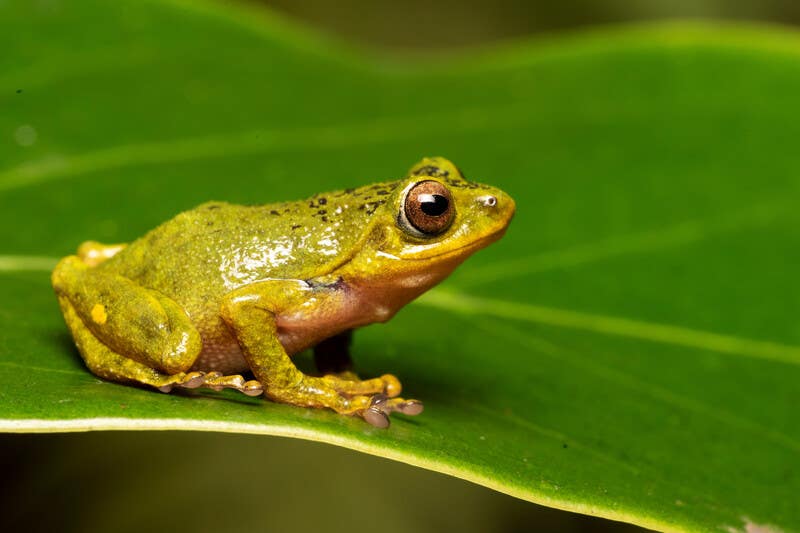Re:wild loves a good good news story! And in recent findings that 41% of amphibians are facing some likelihood of extinction, we are encouraged that other species are actually doing better than they were 20 years ago, when scientists for the first time ever took a look at the extinction risk of all known species of amphibians (known as the first Global Amphibian Assessment).
According to the second Global Amphibian Assessment, which just wrapped up this year under Re:wild’s lead, in some cases, amphibians have bounced back from the brink of extinction of their own accord, surprising conservationists and amphibian scientists. In other cases, strategic conservation efforts—from fencing off non-native predators to ending destructive mining activities—have made the difference between survival and extinction, though many of these species continue to face ongoing threats that need to be regularly monitored and addressed.
“As a result of the second Global Amphibian Assessment, we now know that conservation actions have led to improvements in status for 63 amphibians since 1980, proving that these animals can recover if given the chance,” says Kelsey Neam, Re:wild species priorities and metrics coordinator. She is also one of the leads on the second Global Amphibian Assessment, an initiative to examine how the extinction risk of more than 8,000 species of frogs, toads and caecilians —limbless, snake-like amphibians— has changed since 2004.
Here are 10 amphibian species giving us hope:
Puerto Rican Crested Toad
Peltophryne lemur 2004 Red List status: Critically Endangered Updated Red List status: Endangered
Named after the bony structures, or crests, that sit above its striking golden eyes, the Puerto Rican Crested Toad roams rocky areas within forests on the island of Puerto Rico, which is nestled within the Caribbean Islands Biodiversity Hotspot. The toad, which has pebbled skin and a distinctive upturned snout, is facing several threats including habitat destruction caused by urban development. In the habitat that still supports the toad, the species is being outcompeted by non-native Giant Marine Toads.
The Puerto Rican Crested Toad needs just the right conditions to breed. It mates after heavy rainfall, but shifting rainfall patterns due to climate change are making it harder for the toad to have successful breeding seasons. The species was classified as Critically Endangered on the IUCN Red List in 2004, but in 2020, its status improved to Endangered thanks to a conservation breeding program that has boosted the wild population by reintroducing more than 500,000 tadpoles across six sites, where Giant Marine Toads are actively removed.
Alcatraz Snouted Treefrog
Scinax alcatraz 2004 Red List status: Critically Endangered Updated Red List status: Vulnerable
This tree-dwelling frog lives on Alcatraz Island off the northern coast of the state of São Paulo in Brazil. Alcatraz was a training ground for the Brazilian Navy and the frogs had trouble coping with the environmental effects of military training. For decades, the species was threatened by firearm training, which also occasionally sparked damaging wildfires on the island. Thanks to the efforts of conservationists, in 2008, the navy and other governmental departments agreed to move the training to an area where the Alcatraz Snouted Treefrog doesn’t live. And in 2016, the island was classified as a wildlife refuge, helping to keep non-native plants and animals away from it. The Brazilian Navy has also agreed to help fight fires on the island. Combined, all of the efforts paid off and the Red List status of the Alcatraz Snouted Treefrog improved from Critically Endangered in 2004 to Vulnerable in 2020.
Yunnan Asian Frog
Nanorana unculuanus 2004 Red List status: Endangered Updated Red List status: Vulnerable
The Yunnan Asian Frog dwells in forests and wetlands in central and southern areas of Yunnan Province in China. In 2004 the frog was classified as Endangered, primarily because of the negative effects of humans harvesting wood from its habitat and collecting the frogs for food. The Chinese government passed a law in 2000 making the collection of wild, threatened species in China illegal. This species is under the protection of the “Law of the People’s Republic of China on the Protection of Wildlife.” This protection and strong efforts to safeguard the species’ habitat improved the frog’s Red List status from Endangered in 2004 to Vulnerable in 2020.
Stephens Island Frog
Leiopelma hamiltoni 2004 Red List status: Endangered Updated Red List status: Vulnerable
New Zealand’s rarest and largest native frog has eyes with round pupils (most frog species have slit-shaped pupils). In 2004, the biggest threats to the Stephens Island Frog, which was named after one of the islands it lives on, included deforestation, wildfires and predation by a native reptile called Tuatara and Black and Polynesian Rats. Thanks to a forest regeneration program and Tuatara-proof fencing around the frog’s habitat, along with the transfer of 71 individuals from Stephens Island onto a different island in 2004 and 2006, the Red List status of this species was updated from Endangered to Vulnerable in 2015.
Naomi’s Forest Frog
Platymantis naomii 2004 Red List status: Vulnerable Updated Red List status: Near Threatened
Naomi’s Forest Frog, which is only found on the sacred Mt. Banahaw on Luzon Island in the Philippines, provides another reason for hope. The frog’s habitat was damaged by pilgrims and tourists, who left waste and built campsites while trekking through the frog’s habitat in the mountains. In 2009, these regions were classified as protected areas, which reduced the number of people entering the higher-elevation areas where the frog lives. As a result, the Red List status of the frog improved from Vulnerable in 2004 to Near Threatened in 2018.
Indigo Bush Frog
Raorchestes indigo 2004 Red List status: Critically Endangered Updated Red List status: Vulnerable
Named after the splashes of bright indigo on its thighs and armpits, the stunning Indigo Bush Frog lives in high-elevation forests in the Kudremukh Massif mountain range in India. Before 2006, mining resulted in destruction of the frog’s habitat, but this is no longer the case, thanks to efforts led by Wildlife First. The NGO brought a legal battle against the mining company Kudremukh Iron Ore Company Limited, resulting in a landmark decision to end all mining in the area by 2006. As a result, the frog was assessed as Vulnerable in 2022 on the IUCN Red List. Conservationists believe that the decision to end mining in Kudremukh Massif likely saved the Indigo Bush Frog from slipping perilously close to extinction.
Dotted Poison Frog
Andinobates dorisswansonae 2004 Red List status: Critically Endangered Updated Red List status: Vulnerable
Characterized by striking red, orange or yellow dots on black or dark brown skin, this beautiful frog roams a single small tract of forest in the Colombian Andes. Habitat destruction caused by logging, agriculture and cattle grazing threatened the species in the past. The forest where it lives is now part of the Ranita Dorada Amphibian Reserve. Although cattle pastures and crops still surround the frog’s habitat, its population is stable, which has led conservationists and researchers to change its Red List classification from Critically Endangered in 2008 to Vulnerable in 2014.
Fei’s Horned Toad
Megophrys feii 2004 Red List status: Critically Endangered Updated Red List status: Near Threatened
Fei’s Horned Toad lives in the forests of China’s Yunnan Province near the border with Myanmar, making its home in shallow streams and pools. Though one of the areas where Fei’s Horned Toad lives is inside the Tongbigan Nature Reserve, that hasn’t always offered the species protection from threats like agriculture and wood harvesting. Much of the forest around Tongbigan has been converted into lemongrass and pepper plantations, as well as smaller subsistence farms. Those plantations and farms had been creeping inside the nature reserve since it was created in 1986.
During the past decade Tongbigan has been more effectively protected against deforestation and Kadoorie Farm and Botanic Garden has been engaging the local community to better protect its unique biodiversity, which has helped Fei’s Horned Toad make an impressive recovery. Had the Tongbigan Nature Reserve not been more effectively managed and protected starting in 2014, conservationists think it’s likely Fei’s Horned Toad would have suffered a steep population decline, putting the species’ survival at risk. But now it’s classified as Near Threatened on the IUCN Red List.
Tinajillas Rain Frog
Pristimantis tinajillas 2004 Red List status: Critically Endangered Updated Red List status: Vulnerable
This tiny brown frog is found in mountainous forests in Ecuador and has been threatened by agriculture, livestock farming, logging and mining. Since 2013, the designation of its habitat as a protected area has helped to reduce these threats, leading to the frog’s Red List status to recently improve from Critically Endangered to Vulnerable.
La Estrella Salamander
Nototriton picadoi 2004 Red List status: Near Threatened Updated Red List status: Least Concern
This small salamander lives in mossy, wet trees and shrubs across the northwestern end of the Cordillera de Talamanca cloud forest in Costa Rica. Also found in the Turrialba volcano in Cordillera Central, the salamander’s habitat was at one time threatened by agriculture and grazing livestock. The combination of several conservation actions and legislative decisions over time, including the elimination of perverse incentives, improved protected area management, and Costa Rica’s Payment for Environmental Services Program established in 1997 have together resulted in the salamander going from Near Threatened in 2004 on the Red List to Least Concern in 2020. [Read more here]
Carissa is a freelance reporter who loves telling stories about protecting biodiversity, improving health equitably and conserving the environment. She has written about fascinating animals, plants, climate change and health for New Scientist, Live Science and Nature.




